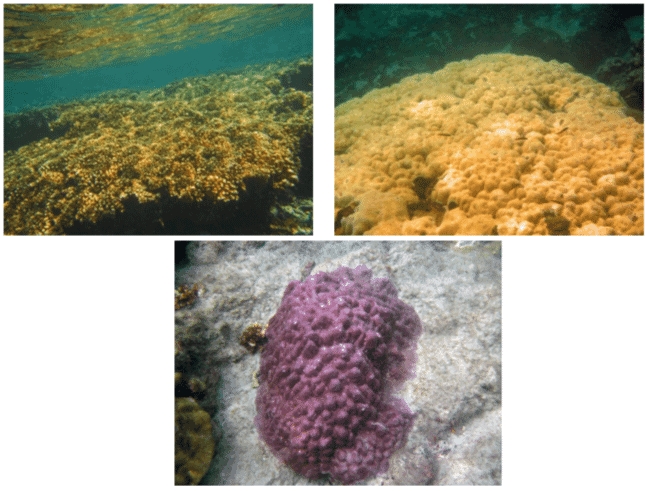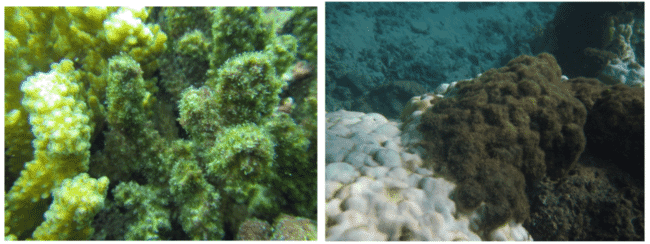They live in an area of only 0.2% of the world's oceans, covering 600, 000 km 2 yet are responsible for some of the most powerful natural antibiotics known, yet at the same time having over 100 distinct species of bacteria associated with each species of coral.
So what is a coral anyway? The majority of Corals are composed of an inner skeleton made up of the common white compound, calcium carbonate. On the outside of this endoskeleton is a thin layer of living tissue that is only a part of the living coral with the other part being composed of a specialized colorful algae known as a zooxanthellae which coexists within the coral tissue as a "symbiont" providing food and oxygen for coral tissue growth.
Most corals are found in shallow well lit areas and may have many different species of Zooxanthellae within their tissue. Corals can only survive brief periods without their zooxanthellae symbionts. They also consume tiny free floating organisms known as plankton by ingesting and digesting them in openings in the coral tissue which are basically stomachs with tentacles.
When corals lose their symbionts due to stress, they stop growing from weeks to months after recovering with new zooxanthellae, sadly most corals die when algae are expelled from their tissue, before they can acquire a new algae.
What would cause a coral to lose its colorful algae to expose the super white endoskeleton underneath also known as coral bleaching? Corals have been reduced in abundance by 50% during the last 30 years in the Caribbean.
Unrestricted fishing and deforestation of coastal areas have been reported to the main long term variables resulting in coral death. However, a simple change in the environment can cause coral bleaching. Corals are fragile organisms that are easily affected by a change in temperature, for example. Bleaching may occur when the seasonal ocean temperature average increase as little as above 1oC. Coral Biologists have stated that the reproduction rates of corals are affected for at least three years after a "bleaching event".
Global warming was concluded to not be the main culprit of coral "bleaching" from a meeting of Reef Scientists in 1991, but changes in temperature due to el Niño are an awesome threat to coral reefs.
Changing weather patterns due to el Niño cause warm water from Asia to move towards the pacific side of Panama causing an increase in sea surface temperature. This occurs infrequently from 3-7 years. Panama corals died at the rate of about 80% during the intense el nino period of 1982-83 which increased temperatures to 3-4oC higher than the seasonal average and four years later corals showed minimal signs of recovery. In the Galapagos Islands 99% of Corals died during the same period while 12% of the corals where lost during the el nino of 97-98.
On the Caribbean Coast of Panama during July, 2009, temperatures rose to 4-5oC above normal and with low dissolved oxygen contributed to bleaching of Corals. Corals dying next to healthy looking colonies is not uncommon and may be indicative of the varying thermal tolerance of individual colonies.
According to weather experts, the nino of 2015 is turning out to be one of the most intense on record. Although the exact date of the start and end of el nino event is hard to predict, most experts agree that el nino started sometime during September-October, 2015 and will likely end sometime during the spring of 2016.
According to the Smithsonian Tropical Research Institute in Panama City, warm water from the el nino effect reached the shores of Panama in April, 2015 and corals at Coiba island were reported to have started to fade during that period. By August there were widely noticeable mortalities.
Scientists studying the coral die off at Coiba Island on the Pacific side of Panama think some of the corals are surviving and acclimatizing. These results concur with what has been observed to be happening at Seca Islands by Dr Bill McGraw, environmental scientist and aquaculture researcher.

Pictures taken between 2012 to July 2016 shows no bleaching of Corals anywhere around the Seca Islands study area.
During dives at the Playa Pargo at Seca Islands, 27 km from the main land of Panama from 2012 to July 2015, Corals viewed were always in great condition without any bleaching ever being noticed (Figure 2).

Pictures taken on 13-Sept 2015 show the bleaching of stony corals.
Observations of Corals on 17-May-15 were no different. However from 16-July, 2015 onwards, there was a dramatic bleaching event (Figure 3) with individual species, depth, degree and color variety changing at different rates, obviously displaying variance in temperature tolerance as previously stated.

Picture from 10-Jan-16 showing the changing color of the Porites coral from purple to a brilliant blue, likely due to change in the color of the symbiotic algae due to a different species of symbiont or a change in the pigments of the algae already present in the coral.
The large blanket-bubble type Porites coral apparently had adapted to the effect of the el Niño event by changing color (Figure 4) possible due to expelling one or more symbiotic algae, and others died as confirmed by the presence of alga cover (Figure 5).

Pictures taken on 10-nov-16 and 10-Jan-16 showing algae growing on the coral skeleton of the branching stony coral (left) and a Porites coral (right) confirming mortality.
Unlike the results reported at the Coiba Islands, the two coral species making up about 95% of the corals at the Playa Pargo site, branching corals and the large Porites, both showed evidence of massive bleaching with only the Porites showing color change in response to the thermal stress until 25-March, when the branching coral showing a bright green symbiont, obviously different than the fleshy algae covering dead coral (Figure 6).

New color variety of SPS stony coral (upper left) and small new growth (upper right), new color morphs of Porites (the rest of the photos) first seen on 25-Mar-16.
The Porites continued to change color to tan and green from brilliant blue (so far transition color only), with some of the original purple Porites now looking darker and dull in color.
After the Bleach
High species diversity in corals may be maintained by continual change in conjunction with changing symbiont algal species. Re-colonization by corals in a disturbed habitat such as post bleach, may result in an increase in species which may in part due to the enhancement of recruitment of coral larvae (Planulae) by a temporary increase in temperature. Grazing by sea urchins and large herbivorous fish are well known to help corals compete with fast growing algae which seek to colonize any slow growth.
With the overharvesting of larger herbivorous fish, coral mortality is likely due to the remaining smaller fish unable to control excessive algal growth. Algae release more organic carbon into the water than all the CO2 in the atmosphere. This organic carbon then contributes to a rise in bacteria which are detrimental to corals, this has been shown time and again in experimentation.
Bleaching events have been predicted by some scientists to eventually begin occurring on a yearly basis due to the stress of higher CO2 in the atmosphere. Although one thing is for sure, the next el Niño will contribute to more mortality and more change, albeit according to the latest research, less dramatic due to adaptation and acclimation of Corals to increasing ocean temperatures.


